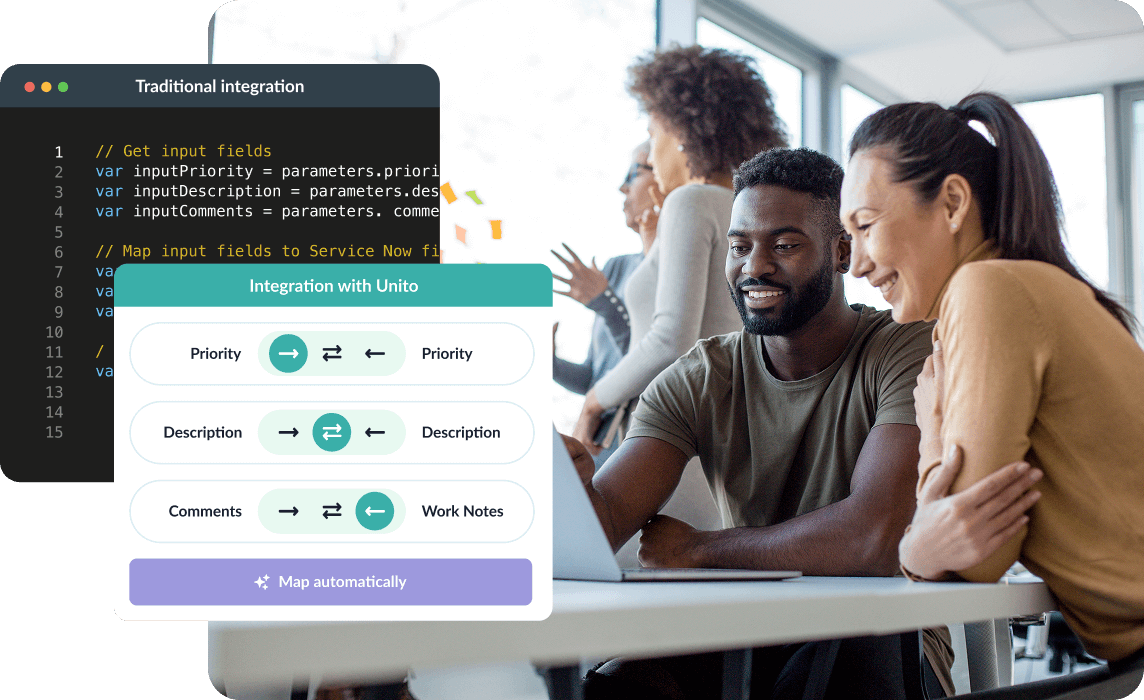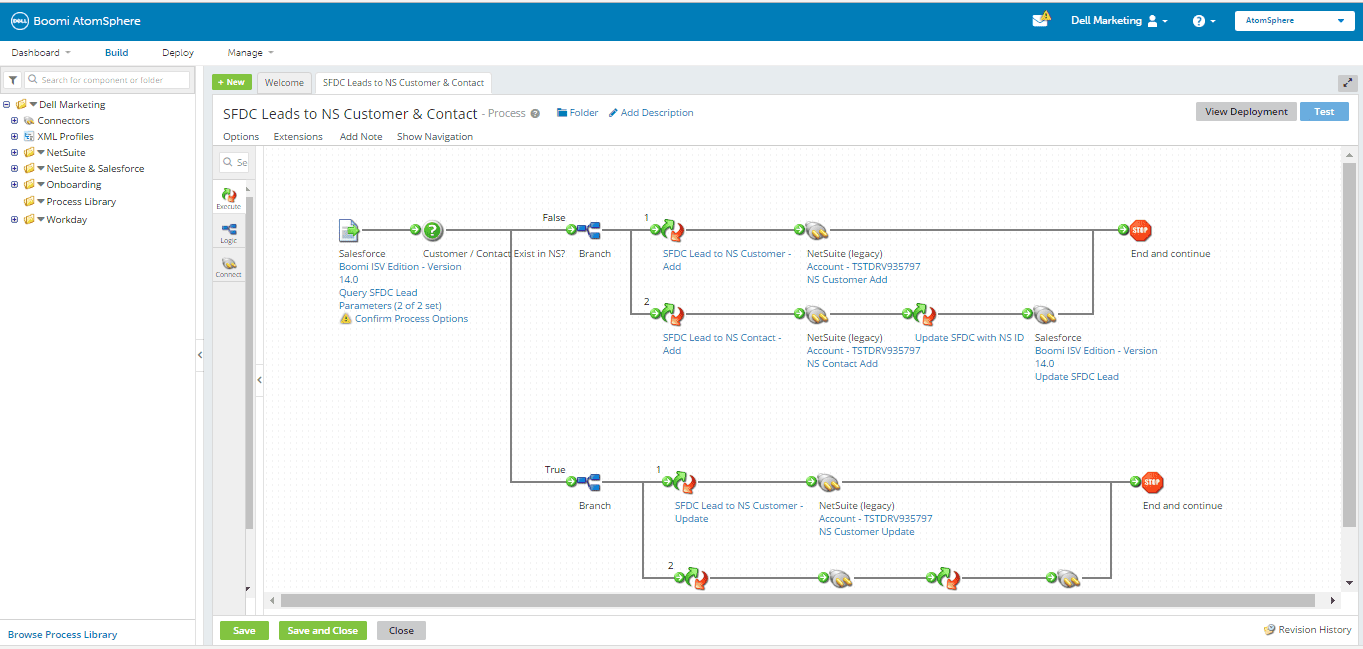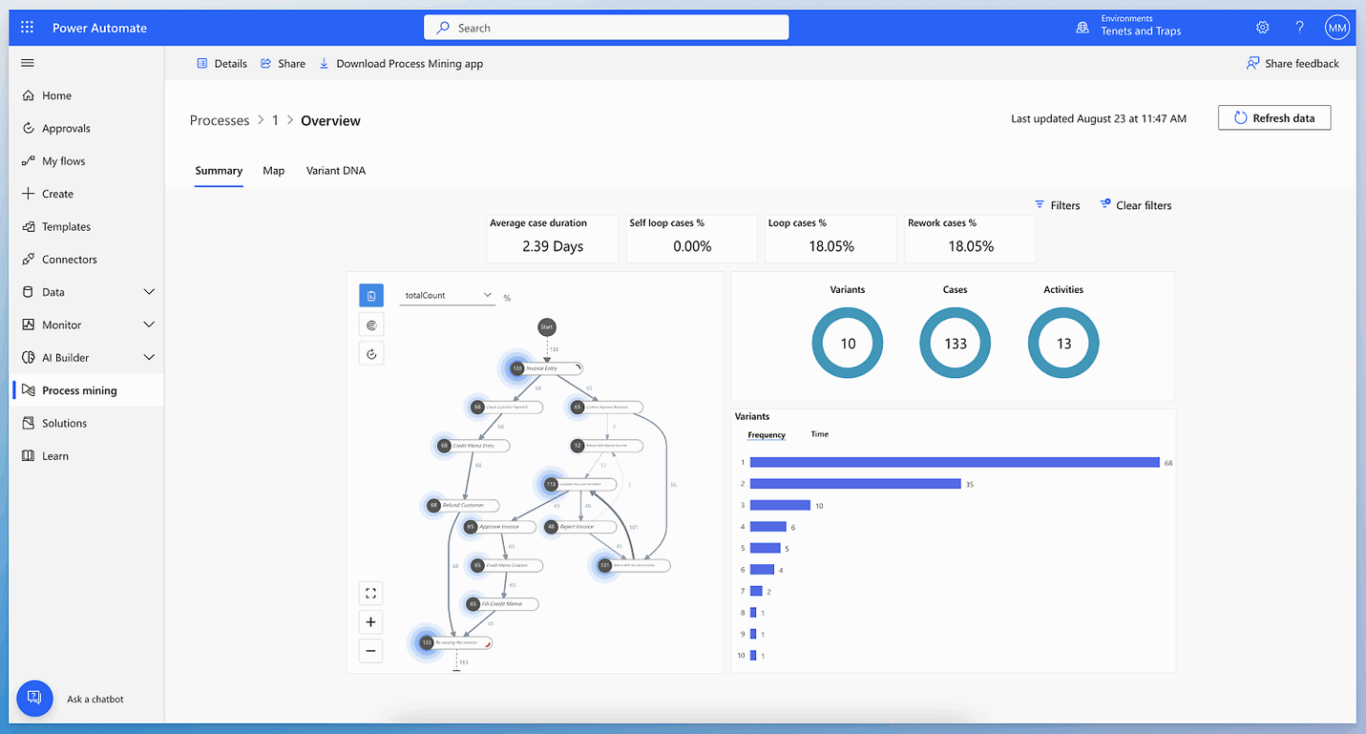The 10 Best Cloud Integration Platforms: Complete Comparison Guide
Software integration isn’t just becoming more essential to how your organization works, it’s already a core problem. According to data from Merge, 83% of organizations see product integrations as one of their biggest priorities. Cloud integration platforms are one of the best ways of doing this, They connect business systems without requiring significant IT resources, lengthy deployment times, or on-premise servers and architecture. Modern cloud platforms can be deployed in days rather than months, meaning you see a near-instant impact.
What are cloud integration platforms?
Cloud integration platforms are purpose-built integration solutions delivered over the cloud, much like most of the software your organization relies on. These solutions connect applications to move data between them, allowing teams to work across tools without manually moving that data. These platforms enable:
- Application connectivity across cloud and on-premise systems.
- Data synchronization that keeps information consistent across tools.
- Workflow automation, eliminating manual data transfer tasks.
- API management, for building your own integrations.
- Pre-built connectors you can deploy in days or weeks.
Cloud integration vs. native integrations
Native integrations are integrations built into other software tools. Project management tools, for example, might have native integrations that pair them with other project management tools, spreadsheets, or databases. Software development platforms like GitHub have native integrations for messaging tools like Slack and Microsoft Teams, allowing developers to automatically share updates with other teams as they work.
While native integrations are simple to deploy and use, they come with some limitations:
- Limited scope, whether that’s in available tools or in the functionality of integrations.
- Minimal customization, such as limited supported fields or automation behavior.
- Limited scalability, meaning these integrations can rarely support larger teams.
- Increased data silos, as more and more data is trapped in a single tool.
Comparatively, cloud integrations are stand-alone tools, and usually have more robust integration capabilities. They’re typically more scalable and customizable as well.
Best cloud integration platforms: Summary table
| Cloud integration platform | Starting price | Integration type | Number of connectors | Best for |
| Unito | $49/month | Two-way, real-time | 60+ | Two-way syncing |
| Zapier | Free plan, with paid plans starting at $19.99 a month | One-way automation | 7,000+ | Simple automations |
| Workato | $10,000/year | Trigger-action automation | 1,000+ | Enterprise automation |
| Mulesoft | $27,000/year for Composer, custom pricing for Anypoint | No-code integration and API management | Hundreds | Salesforce integration |
| Integrately | Free plan, with paid plans starting at $29.99 a month | One-way automation | 1,200+ | Budget-conscious teams |
| Tray.io | Custom, usage-based pricing | Low-code and API management | 600+ | Customized workflows |
| Informatica | Custom pricing | No-code enterprise integration | 400+ | Legacy integration |
| Jitterbit Harmony | Custom pricing | Low-code integration | 400+ | E-commerce integration |
| Boomi | Custom, per-connector pricing | Hybrid | 300,000+ | Enterprise integration |
| Power Automate | $15 per user, per month | Automation and RPA | 400+ | Microsoft 365 Integration |
The 10 best cloud integration platforms
Unito: Best two-way sync cloud integration platform

Unito is a no-code cloud integration platform with some of the deepest two-way integrations on the market. These integrations support tools like Asana, Jira, Smartsheet, Salesforce, and ServiceNow, as well as more than 50 others. A fully customizable platform with enterprise-grade security, Unito can support any workflow as it scales, from collaborative software development to support request escalation. Its no-code interface and 12-minute average setup time mean you start seeing results quickly.
Strengths
- Real-time, bidirectional sync
- 60+ pre-built connectors
- Deep field support and custom transformation rules
- No-code visual interface
- SOC 2 Type II security certification
Main limitation
Unito has over 60 integrations, which is fewer than other integration platforms.
Customer rating

Zaper: Best automation platform for breadth of connectors
Zapier’s workflows are a staple in the cloud integration world. Built around triggers and actions, Zaps automate work between tools in a direct fashion. As a veteran in this space, Zapier offers a huge selection of 7000+ connectors to work with. Zapier works best for organizations that need efficient integration for numerous tools at scale.
Strengths
- Massive library of integrations
- Quick setup with visual workflow builder
- Prebuilt templates for common automation scenarios
- Webhook support
Main limitation
Zapier automations only sync data in one direction and can be limited in their depth.
Pricing
Zapier offers a free entry level plan with 100 tasks per month, a great way to get started. The plans start at $19.99 for the Professional plan for individuals, and $69.00 for the Team plan, and scale up in price depending on the number of tasks you need each month. Custom plans are available for Enterprise customers.
Workato: Best for enterprise automation
Workato is an enterprise-level option that facilitates large-scale integrations. It has a number of solutions for companies integrating at scale. Like Zapier, Workato uses a trigger-and-action model to run their automations. Alongside other expected Enterprise features, Workato also offers either embedded or white-label IPAAS that can be included as a feature in other software. With a huge selection of integrations to choose from, Workato makes sense for enterprises that need an efficient solution for integrating numerous tools.
Strengths
- 1000+ enterprise connectors
- Advanced conditional logic and branching
- Embedded iPaaS for product integration
- Workbot for automating updates to Slack and Teams
- Enterprise-grade security and governance
Main limitation
Workato integrations can be complex and expensive to set up.
Pricing
Workato is an enterprise-only service, with the price to match. Pricing is available only by contacting sales. Their entry on Capterra lists the starting price as $10,000.
Mulesoft: Best for Salesforce ecosystems
Mulesoft for Salesforce offers two enterprise level integration software that can be deployed independently or as a pair: Composer for most teams and Anypoint for IT. Composer is a user-friendly no-code integration software. Using templates and pre-built connectors, users and teams can build their own workflows without IT assistance to integrate Salesforce. On the other end, Anypoint is a tool for IT teams to develop, manage, and deploy their own APIs and integrations. The option to deploy on the cloud, hybrid, or on-premise gives teams valuable flexibility. When paired with Composer, integrations and APIs developed in Anypoint can easily be deployed to Composer for users to leverage.
Strengths
- No-code for Salesforce users
- Full API development and management
- Cloud, hybrid, and on-premise deployments
- Pre-built templates and connectors
- Enterprise-grade security
Main limitation
Not ideal for smaller organizations, especially if they don’t use Salesforce.
Pricing
Anypoint pricing is available only by quote, while Composer starts at $27,000 for three connectors and 250k tasks.
Integrately: Best for small budgets
Stepping away from enterprise software, Integrately has a strong offering for teams that need ease of use and a wide selection of connectors, all without breaking the bank. Prioritizing ease of use, Integrately has over 20,000,000 pre-made automations for 1200+ apps. They offer one-click automations for these premade templates which makes them some of the easiest automations to deploy. This, paired with the excellent pricing, make this tool one of the most accessible and affordable on this list.
Strengths
- 20,000,000+ pre-built automations
- 1,200+ integrations
- One-click automation deployment
- Two-minute sync intervals
- Visual workflow builder
Main limitation
Less customizable than other options on this list.
Pricing
A free plan with 100 tasks, a15-minute update time, five automations, and chat support makes it easy to get started. Higher plans raise the number of tasks available, and decrease the update time down to only 2 minutes. The Business plan at the top provides 150k tasks, more complex customization, and lots more, for $239. No enterprise-level plans are available currently.
Tray.io: Best low-code platform
Tray.io is a low-code integration and automation platform. They offer an impressive selection of connectors to get you started, and a visual workflow builder that helps keep track of how your workflow is integrated and what tools it’s integrated with. Tray.io also has full code API development tools for teams that want to leverage Tray.io’s pre-made integrations alongside custom ones. The option to use low-code or fully custom integrations means Tray.io can be adapted to a wide variety of use cases.
Strengths
- Visual workflow builder enhanced with coding knowledge
- Extensive connector library
- Custom API development tools
- Advanced data transformation
Main limitation
More complex than pure, no-code tools.
Pricing
Tray.io offers three plans: Pro, Team, and Enterprise. Enterprise level plans have the option of adding an Embedded Bundle to their plan, which allows the enterprise to use Tray.io as a feature of their own product. Usage is pay-as-you-go, so the price varies according to usage. Price will be calculated with your plan, plus usage and add-ons. You can get more details by reaching out to their sales team.
Informatica: Best for legacy system integration
Informatica’s API and Application Integration is an enterprise-grade automation, integration, and IPAAS tool. It uses a no-code UI and a visual builder with nodes that helps keep things visible and clear when building larger, more complex workflows. It also includes tools to help manage APIs and build custom apps. A unique feature is the ability to integrate legacy apps that have no native cloud connectivity, a capability that opens up lots of possibilities for larger organizations that may depend on niche legacy tools.
Strengths
- Integration for legacy systems
- No-code visual builder
- API management and custom app-building
- Supports complex data management
Main limitation
Too costly for small teams or budget-conscious organizations.
Pricing
Informatica does not have tiered plans. Rather they offer consumption-based pricing using Informatica Pricing Units (IPUs), which function as a token system. This allows for more flexibility for the end user than more traditional pricing. Quotes are available by contacting Informatica.
Jitterbit Harmony: Best for e-commerce integration
Harmony is an IPAAS platform by Jitterbit. It is a low-code interface for creating workflows, building automations, and managing APIs. Jitterbit’s platform also includes data management solutions, and backend to e-commerce connections. For teams whose needs match Jitterbit’s offering and can operate with a low-code interface, Harmony is a great option.
Strengths
- Low-code workflow interface
- E-commerce focus
- Backend-to-frontend integration
- Advanced data transformation capabilities
Main limitation
Harmony’s flexible, low-code solution can be harder to deploy than other solutions.
Pricing
Jitterbit offers three plans, Standard, Professional, and Enterprise. They also offer a 30 day free trial. Specific pricing quotes are available by reaching out to their sales team. Plans scale up in features, but they all have access to the same add-ons. One standout extra for the Enterprise plan is a 24-hour emergency hotline.
Boomi: Best hybrid cloud integration

Boomi allows users to build their own integrations through an iPaaS (integration platform as a service) interface to move data seamlessly between tools. AI agents allow you to automate a large part of this, while built-in API management makes the platform more flexible overall.
Strengths
- Cloud and on-premise deployment.
- 300,000+ possible app connections
- Visual integration builder
- Legacy-to-cloud migration
Main limitation
Boomi is an expensive platform with a complex setup and a steep learning curve.
Pricing
Custom, per-connector pricing.
Microsoft Power Automate: Best for Microsoft environments

Microsoft Power Automate integrates seamlessly with your Microsoft environment and over 400 external connectors. If you need native integrations with the Microsoft tools you use every day, then Power Automate is one of your better options.
Strengths
- Deep Microsoft 365 integration
- 400+ third-party connectors
- AI builder for intelligent automation
- Enterprise-grade governance features
Main limitation
Best-suited to Microsoft environments.
Pricing
Starts at $15 per user, per month.
Ready to try the best cloud integration platform on the market?
You have tons of choices in front of you, but if you need a two-way sync platform that anyone in your organization can learn quickly, you need Unito. Integrate project management tools, spreadsheets, databases, CRMs, and more with one tool.
Want to see what Unito can do?
Meet with a Unito product expert to see how the right integration can transform the way you work.
FAQ: Cloud integration platforms
What’s the difference between cloud integration platforms and iPaaS?
There’s no difference. An iPaaS (integration platform as a service) is a cloud integration platform. That’s just the more technical term.
Can cloud integration platforms handle real-time data sync?
Some platforms can handle data changes in real-time. Others sync changes every few minutes, every 15 minutes, or even just a few times a day.
Which platform is best for non-technical users?
If you need a two-way sync, Unito is the best platform that anyone can use. For simple, one-way automations, Zapier is a strong fit.
Recent updates
October 3rd, 2025: We added a summary table at the beginning of this article so you get an immediate breakdown of the differences between these solutions. We also bulked up each entry on this list and improved the “what is a cloud integration platform” section. Added new options to the list. Added an FAQ.


